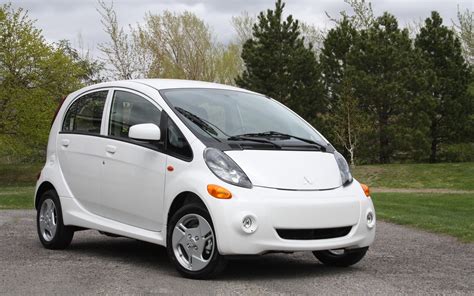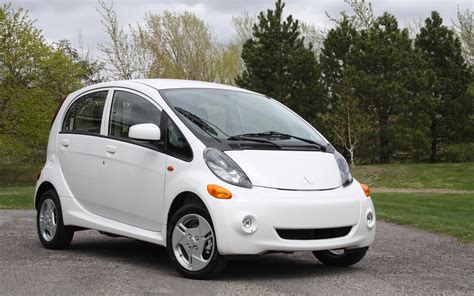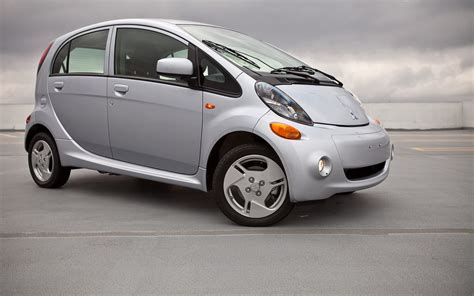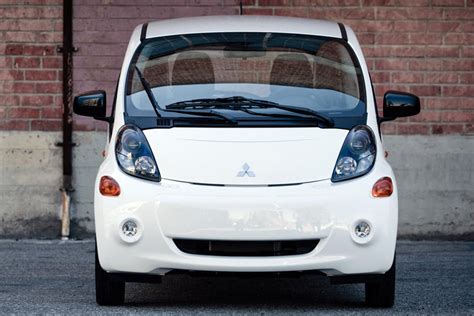2017 Mitsubishi I-miev problems

The Mitsubishi i-MiEV (MiEV is an acronym for Mitsubishi innovative Electric Vehicle) is a five-door electric kei car produced in the 2010s by Mitsubishi Motors, and is the electric version of the Mitsubishi i. Rebadged variants of the i-MiEV are also sold by PSA as the Peugeot iOn and Citroën C-Zero, mainly in Europe. The i-MiEV was the world's first modern highway-capable mass production electric car.
The i-MiEV was launched for fleet customers in Japan in July 2009, and on April 1, 2010, for the wider public. International sales to Asia, Australia and Europe started in 2010, with further markers in 2011 including Central and South America. Fleet and retail customer deliveries in the U.S. and Canada began in December 2011. The American-only version is larger than the Japanese version and has several additional features.
According to the manufacturer, the i-MiEV all-electric range is 160 kilometres (100 mi) on the Japanese test cycle. The range for the 2012 model year American version is 62 miles (100 km) on the United States Environmental Protection Agency's (US EPA) cycle. In November 2011 the Mitsubishi i ranked first in EPA's 2012 Annual Fuel Economy Guide, and became the most fuel efficient EPA certified vehicle in the U.S. for all fuels ever, until it was surpassed by the Honda Fit EV in June 2012 and the BMW i3, Chevrolet Spark EV, Volkswagen e-Golf, and Fiat 500e in succeeding years.
As of July 2014, Japan ranked as the leading market with over 10,000 i-MiEVs sold, followed by Norway with more than 4,900 units, France with over 4,700 units, Germany with more than 2,400 units, all three European countries accounting for the three variants of the i-MiEV family sold in Europe; and the United States with over 1,800 i-MiEVs sold through August 2014. As of early March 2015, and accounting for all variants of the i-MiEV, including the two minicab MiEV versions sold in Japan, global sales totaled over 50,000 units since 2009.

Social links
Common 2017 Mitsubishi I-miev problems
The common problems reported by owners of the 2017 Mitsubishi i-MiEV include:
- Safety Concerns: Safety is a weak point for the i-MiEV, with the NHTSA rating it at four stars out of five for overall safety. It received only three stars for side impact safety and four stars for frontal crash and rollover safety. The lack of active safety features like adaptive cruise control and automatic crash braking raises safety concerns.
- Charging Time: The i-MiEV's onboard charger is only 3.3 kilowatts, resulting in a long charging time. Mitsubishi quotes a 14-hour charge time on household current and 7 hours at a 15-amp Level 2 charging station. While the CHAdeMO DC quick-charging port can recharge up to 80% of the battery in less than 30 minutes, the availability of such stations may be limited.
- Outdated Design and Features: The 2017 i-MiEV's design and features have not seen significant updates since its earlier versions. Its age shows in various aspects of design, performance, and specifications, making it more suitable for city and suburban errands rather than longer trips or more demanding driving conditions.
These issues highlight some of the key concerns raised by owners of the 2017 Mitsubishi i-MiEV.

Why was Mitsubishi i-MiEV discontinued?
According to Nikkei, the reason the i-MiEV went so long unchanged was a lack of funding and resources. But now that Mitsubishi is part of the Renault-Nissan Alliance, the news outlet reports that there will be a successor to the bubbly EV co-developed with Nissan to be launched in 2023.
How long does Mitsubishi i-MiEV last?
| Mitsubishi i-MiEV | |
|---|---|
| Transmission | Single speed reduction gear |
| Battery | 16 kWh / 58 MJ (Li-ion battery) |
| Range | 160 km (99 mi) (Japanese cycle) 100 km (62 mi) (US EPA cycle) |
| Plug-in charging | 15 A 240 V AC (3.6 kW) on the SAE J1772-2009 inlet, optional CHAdeMO DC rapid charging, adapters for domestic AC sockets (110–240 V) |
What is the range of the 2017 I-MiEV?
59 miles
According to the EPA, the2017 Mitsubishi i-MiEV has an estimated driving range of just 59 miles. That's far less than the i-MiEV's competitors that typically have 75-85 miles of range. (The Nissan Leaf, with its optional battery, can go more than 100 miles.)
What is the recall on the Mitsubishi i-MiEV?
Mitsubishi Motors North America, Inc. (MMNA) is recalling certain 2012-2017 i-MiEV vehicles. Water may penetrate the brake assist vacuum pump, causing corrosion and a failure of the brake vacuum pump.
2017 Mitsubishi I-miev complaints
The NHTSA has received 0 complaints about various vehicle components related to the 2017 Mitsubishi I-miev.
You can leave your car complaint via the special form below.
2017 Mitsubishi I-miev recalls
The National Highway Traffic Safety Administration (NHTSA) has issued 2 recalls for different components of the 2017 Mitsubishi I-miev.
- Manufacturer: Mitsubishi Motors North America, Inc.
- Components: SERVICE BRAKES, HYDRAULIC:POWER ASSIST:VACUUM
- Summary: Mitsubishi Motors North America, Inc. (MMNA) is recalling certain 2012-2017 i-MiEV vehicles. Water may penetrate the brake assist vacuum pump, causing corrosion and a failure of the brake vacuum pump.
- Consequence: Without the brake vacuum pump, the driver will experience a sudden loss of braking assist, lengthening the distance needed to stop the vehicle and increasing the risk of a crash.
- Remedy: MMNA will notify owners, and dealers will replace the brake vacuum pump, free of charge. The recall began January 7, 2020. Owners may contact MMNA customer service at 1-888-648-7820. MMNA's number for this recall is SR-19-002.
- Manufacturer: Mitsubishi Motors North America, Inc.
- Components: AIR BAGS:FRONTAL:PASSENGER SIDE:INFLATOR MODULE
- Summary: Mitsubishi Motors North America, Inc. (MMNA) is recalling all 2016-2017 i-MiEV vehicles, equipped with certain air bag inflators assembled as part of the passenger frontal air bag modules used as original equipment or replacement equipment. In the event of a crash necessitating deployment of the passenger frontal air bag, these inflators may rupture due to propellant degradation occurring after long-term exposure to absolute humidity and temperature cycling.
- Consequence: An inflator rupture may result in metal fragments striking the vehicle occupants resulting in serious injury or death.
- Remedy: MMNA will notify owners, and dealers will replace the passenger side frontal air bag inflator, free of charge. The recall began on December 15, 2017. Owners may contact MMNA customer service at 1-888-648-7820. MMNA's number for this recall is SR-17-008.
Negative 2017 Mitsubishi I-miev car reviews
Positive 2017 Mitsubishi I-miev car reviews
-

I've only owned this car for a month, but I have no regrets. Since buying it, I've hardly used my other vehicle. The car has enough torque and acceleration to pull away from the crowd at traffic lights if you want to. While it may not be the most comfortable for all-day driving, it's perfectly adequate for an hour or less. Although the initial cost may be higher compared to other compact cars, the eventual total cost of ownership is calculated to be lower. It's worth paying a little more upfront for greater benefits down the road. Additionally, the vehicle is very stable since the wheels are located at the corners.
-

Wow, it sounds like you had an amazing experience with your new vehicle! From Virginia to Eastern Pennsylvania, through wicked storms and heavy traffic, your car handled it all like a dream. And the best part? You were able to stop at Nissan dealers for free charges on the way home, which cost you absolutely nothing! That's incredible! With an average cost of only $2.51 per 100 miles or $12.55 for 500 miles of driving, you really can't beat it. Plus, if you fill it up overnight, the cost goes even lower. It sounds like you made a fantastic purchase that will serve you well for work and beyond!
-

I have had this car over six weeks now and use it for my daily commute of 45 kilometers (27 miles) each way, putting on sometimes well over 100 kilometers with a few bars in the power gauge to spare.This car is very comfortable and has all the features of a modern vehicle.Don't believe the spin that this car is lacking in anything, this car is truly reaching greater masses as the affordable alternative to the high priced electric cars now being offered by other manufacturers.This car is well designed and has plenty of power with a lot of range.This is the one that scares the oil companies and the car repair shops.
-

This car is fantastic! I was looking for a car that would be perfect for city driving since I don't usually drive more than 65 miles at a time, and this car fits the bill perfectly. On the first day, it was really hot outside (94 degrees), but the AC worked great and I was able to drive 65 miles in total comfort. The ride was smooth, the pick-up was perky, and the front seat was roomy enough for me (I'm 5 foot 11). When I got home, I plugged it into my 240v charger, had lunch, read my mail, and then drove out again on a partial charge. And the best part? No gas needed! I'm extremely satisfied with this car and I absolutely love it!
-

What would you like your electric car to do? Do you want it to zip around and make you look cool? There's a Tesla for that. Or perhaps you're looking for a practical wagon/hatchback that you can use for slightly longer range trips? In that case, you might want to consider the VW e-Golf, Nissan Leaf, or Kia Soul EV. If you're looking for a small, practical, and extremely economical run-around car for errands with the kids and groceries that's also pretty fun to drive, then the Mitsubishi i MiEV, Spark EV, and Fiat 500e are great options. In my opinion, the i MiEV is the most cost-effective EV option available, depending on the price you can pick one up for. A few weeks ago, we bought a '16 i MiEV after trying and crunching numbers on several of the other cars listed above. It may not have the most acceleration, range, or best handling, but it is definitely the most economical EV option we could find. We got ours for what we think was a great deal (especially including the up-to-7500 tax credit: check your own tax situation before you assume a 7500 rebate on the price of the car...) and it fits precisely what we need/want it for. Although we wish our iMiEV would go farther and charge faster, we weren't even considering roughly double the net price (after the tax rebate) for things that for us are pretty marginal considerations. If you're using this car to bop around town or for a reasonable-length daily commute as a second The CHAdeMO fast charger included with the car is a great feature for those rare occasions when you need to go beyond its range. For me, it was an adventure driving it back home from the dealer, which was many times farther away than the car's range. The reduced range doesn't affect us at all for our daily needs. While it's not a Tesla roadster or a sportscar, it's still pretty fun to drive. It's not designed for cross-country road trips, but it's perfect as a second car for urban areas. If you're looking for an affordable car that's efficient and cost-effective, the i MiEV is the way to go. It's not a 200-mile range car, but it's also not priced like one. With up to $7,500 in federal tax credit and possibly even more in state tax rebate, the net price of the car is surprisingly low. I'll take one, please!
Additional sources
More sources of information about 2017 Mitsubishi I-miev problems:
The Mitsubishi i-MiEV Is the Most Pathetic EV In Existence : r ...
Jun 29, 2023 ... It is my dream to someday have a collection with all of these compliance cars like the iMiEV, Focus Electric, Ford Ranger EV, Mazda MX30 and the ...
Problem Charging but it isn't the battery | Mitsubishi i-MiEV Forum
Dec 9, 2017 ... and the only identified conflict has been with a dual-port ChargePoint public EVSE where the two ports share a common power line, in which case ...
2014 Mitsubishi i-MiEV Repair: Service and Maintenance Cost
Get 2014 Mitsubishi i-MiEV repair and maintenance costs, common problems, recalls, and more. Find certified Mitsubishi mechanics near you.
Cold start up Problem | Mitsubishi i-MiEV Forum
Jan 8, 2017 ... Well-known member ... I turn the ignition to the self check position and all the systems cycle turning off the warning light, and when I go to ...

2017 Mirage brake shoe problems... (some aftermarket shoes won't ...
Part number for it is 924RSS. I looked up the fitment for the 2017 Mirage shoes on rockauto and it shows: MITSUBISHI I-MIEV 2014-2017
Other years of Mitsubishi I-miev


Are you having problems with your 2017 Mitsubishi I-miev?



Andre Morissette 2024-09-28
After 2 weeks of daily driving, I am still as satisfied as the first day I got my i-MiEV. It is easy to park, comfortable for its size, and the best part is that it requires NO GAS! If I may suggest some improvements for the i-MiEV engineers, it would be to improve the noise isolation from outside. When in traffic, one can hear outside noise even with the windows closed. Additionally, the suspension/stability could be improved to make freeway commuting smoother and minimize susceptibility to strong winds. Overall, I am very satisfied with the i-MiEV and I highly recommend it if your routine commute is within 50-60 miles in between charges.
Brook Abernathy 2024-05-15
Hi there! I hope you're doing well. I wanted to share my experience with my Mitsubishi Miev that I bought back in 2013. It's a great car that has served me well over the years, despite being a bit basic. However, I've noticed that the battery range has declined quite a bit over time, which is a bit disappointing. Even though I don't drive it very often, the range has dropped to around 35-40 miles inconsistently. I was really counting on the 10-year battery warranty, but unfortunately, Mitsubishi has refused to honor it. I think it's important to consider this when buying an electric vehicle, and I would recommend looking into other companies. Thanks for listening!
Blake Bergstrom 2024-04-14
If San Diego Gas and Electric is your utility, then this review applies. I was one of the first adopters in my S. O'side neighborhood. Since an electric car was an experiment, and no used ones available yet in my local area, I took a plunge on the $12K 2012 Mitsubishi. Even with the special SDG&E EV rates, which require you to charge only at night or pay a penalty, I am averaging 20 miles/$. The Mitsu Mirage gets 50 mpg which at the current price of $3/gallon, works out to 16 miles/$. At around 30K miles, my range is down about 10%. I figure by 40K miles, the car will not be worth keeping unless Mitsubishi honors the battery warranty. Since a replacement battery is $10K, and the car is worth around $4K on Craigs List now, my car has depreciated around $2K/year. I looked at used Mirages, and they depreciate less, and, are able to get you to work and back after 40K miles. I wonder what California will do with all of the 4 and 5 year old electric cars that are just now trickling into junk yards. Will I buy another electric? Heck yeah, but let's see how the 200-mile latest and greatest (Chevy Bolt or Tesla Model 3) holds-up first. Sometime in 2018, I'll have to switch to driving my Mitsubishi SUV to work. One last thing, there are so many electric cars in S. Calif. now that the carpool isn't any faster when traffic is at its worst. Jan 2018 update: Just hit 30K and my range is down 20%. I am just able to make it to work and back. Car still looks great.Too bad some third party doesn't make battery replacements. July 2018 update: I have not noticed any further drop in range. Maybe it's because it is warmer and the car seems to go further in warmer temperatures. Unfortunately, my plant manager won't let me plug my car in at work anymore. I was using an outlet on the side of the building since we have no dedicated EV charger. Now I have to drive my other car whenever I need to go somewhere at lunch or after work since my range has been reduced to getting me to work and back and not much else. For your information, a lot of early Leafs are hitting the junkyard because California hasn't grasped the fact that owners need help funding battery replacements. However, this means I can pick up spare chargers pretty cheap now.